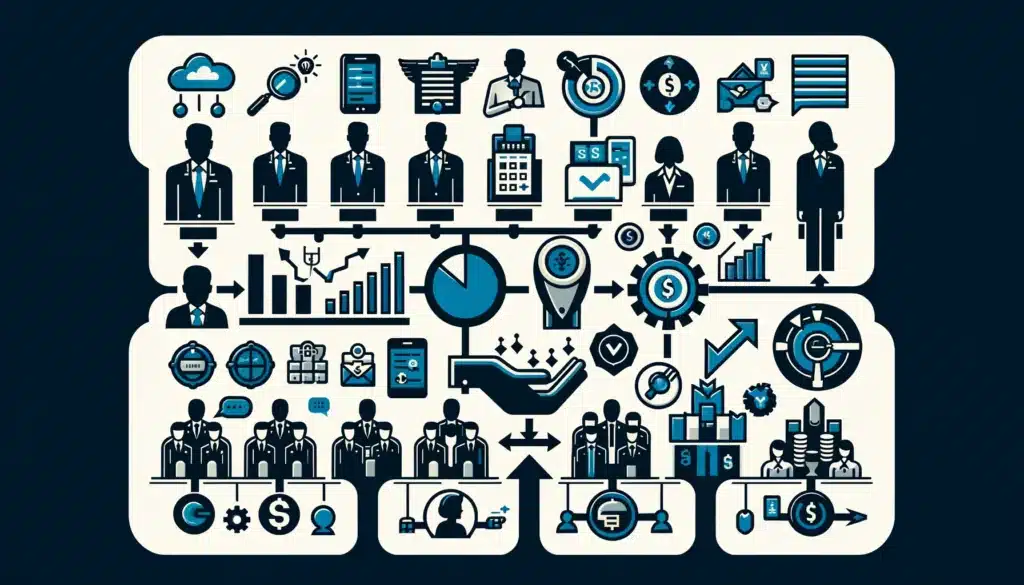A Guide to Effective Forecasting with Jeremy Painkin

In this episode of the Predictable Revenue Podcast, Collin Stewart hosts Jeremy Painkin, SVP at Community Brands, to discuss the essentials of effective forecasting.
Dive into the key elements that can make your organization’s forecast predictable and actionable.
Embrace Rigor in Forecasting
Forecasting isn’t just about numbers; it’s about instilling a rigorous process everyone follows. Jeremy stresses the importance of rigor, noting that while it can spark mixed feelings, it’s crucial for maintaining consistency and accuracy.
Ensuring your team understands and adheres to the process prevents drift and keeps everyone aligned.
Prioritize Predictability
Jeremy highlights the importance of predictability over perfection. Predictable forecasts help you understand what to expect regarding month, quarter, and year revenue. This predictability is vital for communicating with higher-ups and allows for better strategic planning and resource allocation.
Enforce and Test Processes
It’s not enough to set definitions for each stage of the sales process; you need to test them to ensure understanding and adherence. This prevents drift and ensures your team remains aligned with the set processes. Regular testing and enforcement are crucial to maintaining a robust forecasting system.
Make Forecasting a Team Effort
Forecasting is a team sport involving everyone from individual sales reps to senior leadership.
Each team member plays a role: reps forecast their commission potential, middle management focuses on team performance, and senior leaders aim for business stability and growth. Encourage team-wide participation to enhance accuracy and buy-in.
- Inaccurate forecasting can have severe consequences, such as budget cuts or layoffs. A significant miss can lead to drastic measures.
- Accurate forecasting protects your business and employees, ensuring stability and consistent growth.
Securing buy-in from all levels of the organization will create a culture that values predictability. Ensure everyone understands their role in the forecasting process and works together towards common goals. This collective effort will build a resilient and successful organization.

Key Roles in Forecasting and Their Responsibilities
1- Sales Representatives:
Forecasting starts at the rep level. SDRs are on the frontline and responsible for capturing and reporting accurate deal data. They vary from hunters and farmers to enterprise reps, each with different quotas and sales cycles.
2- Sales Managers:
Managers validate the deals. They are the closest to the deal outside the rep, understanding multi-threading, risks, and potential concessions. A good manager provides detailed insights into any agreement and knows their team’s strengths and weaknesses.
3- Directors:
Directors take a broader view, focusing on the team level. They analyze higher dollar amounts, close rates, pipeline coverage, and the impact of potential deal drops.
4- Vice Presidents:
VPs focus on metrics like coverage percentages, pipeline generation, and cash flow projections. They look at trends, product performance, and strategic adjustments to meet targets.
5- Senior Vice Presidents:
SVPs like Jeremy Painkin are concerned with year-over-year growth, product trends, and overall strategic direction. They rely on detailed insights from managers and directors to make informed decisions.
The Importance of Buy-In
Achieving accurate forecasts requires buy-in from all levels. Transparency and collaboration are crucial. When everyone understands the goals and is aligned, they work together effectively, surpassing their quotas.
Real-World Example
Jeremy shared a real-world example of how his team quickly adapted to a last-minute deal fallout. They closed multiple deals on the same day by opening their laptops and collaboratively identifying solutions. This showcases the power of a well-aligned team committed to achieving their targets.
Buy-In for Effective Forecasting
Achieving accurate and reliable sales forecasts hinges significantly on obtaining buy-in from your leaders. It starts by engaging with the organization’s leadership to assess and refine existing processes like BANT or MEDDIC. This involves asking critical questions about who developed these processes and understanding the reasoning behind their current structure.
By involving leaders in discussions about what works and what doesn’t, you gather essential feedback that guides necessary adjustments. This collaborative approach ensures the processes are practical and tailored to the organization’s needs.
Training sessions, such as initial stand-up meetings, help identify areas where team members might struggle with the process. Rather than enforcing rules harshly, it’s about guiding them, showing where they might be missing key components, and reinforcing the correct methods.
The show-share-observe method
Leaders demonstrate the correct approach, share their insights and practices, and then observe their team members replicating these methods. This hands-on guidance helps solidify the process across all levels.
Accountability is crucial. Ensuring that reps’ deals are transparent and visible to the entire team fosters a sense of responsibility and accuracy in data entry. This transparency is critical to maintaining predictable revenue streams.
Leaders should balance guidance with support, avoiding punitive measures that create fear. Instead, they should foster an environment where reps feel comfortable sharing accurate information, which leads to more reliable forecasts.
Involving leaders, refining processes collaboratively, and building a supportive and transparent culture are essential for achieving precise and predictable sales forecasts. This approach ensures everyone is aligned and working towards the same goals, enhancing overall organizational performance.
Shared Definitions and Processes
Clear definitions and processes are essential in sales forecasting. Jeremy emphasizes the importance of having a shared understanding across all levels of the sales organization. This ensures everyone is on the same page and can efficiently contribute to forecasting.
Defining the Stages
Discovery Phase:
- Identify Problem: Recognize the issue the customer is facing.
- Identify Product: Determine the product that will solve the problem.
- Establish Urgency: Understand the urgency of solving the problem.
Propose Phase:
- Executive Buyer: Know who the executive buyer is and ensure the deal is multi-threaded.
- Shared Pricing: Discuss and confirm pricing with the customer.
- Implementation Plan: Share the implementation plan and discuss timelines.
- Paper Process: Understand the approval process, including any legal or board approvals required.
Best Case and Commit:
- Best Case: Deals with a verbal agreement but may lack one element, such as additional approval.
- Commit: Deals that have a verbal agreement and meet all criteria.
Close-Won:
- Executed Order Form: The final stage is when the deal is completed and officially closed.
The Importance of Multi-Threading
Multi-threading is crucial in the propose phase to avoid delays if a key person is unavailable. This involves engaging multiple stakeholders to ensure continuity and prevent bottlenecks.
Ensuring Accuracy and Accountability
Jeremy highlights the importance of covering deals one-for-one at the rep level. Every committed deal should have an equivalent in the best case to ensure targets are met, even if some deals fall through. He also stresses the need for reps to avoid regression in their deals and maintain clear entrance and exit criteria.
Avoiding Regression in Sales Deals
When Jeremy talks about regression, he refers to deals moving backward in the pipeline. This movement can severely disrupt predictability, crucial for accurate sales forecasting.
Challenges of Pushing Deals Forward
Jeremy emphasizes that pushing deals forward, from January to February to March, can indicate a lack of real progress. A key question is, “Is it really a deal?” A good salesperson strives to get a definitive yes or no quickly.
Identifying Roadblocks Early
A common issue Jeremy encountered was reps’ ignorance of necessary approvals, like board meetings or CFO sign-offs. This lack of knowledge can delay deals. The solution? Encourage reps to ask the right questions early to uncover these requirements.
When a deal regresses, it’s a teaching moment. Jeremy asks the team to identify similar gaps in other deals. This collaborative approach helps the entire team learn and avoid repeating the same mistakes.
Importance of Change of Voice
Repetitive communication from the same salesperson can become white noise. Jeremy introduces the concept of “change of voice,” where another team member, like a manager, steps in to communicate with the prospect. This approach refreshes the dialogue and can re-engage a non-responsive prospect.
Process of Change of Voice
- First Level: The manager ensures everything progresses smoothly without pushing for the sale.
- Escalation: If necessary, the rep continues trying, and if there’s still no response, the next level of leadership gets involved.
This tactic is particularly effective for high-level executives, as it aligns communication tone and title to match the prospect’s level.
Win-Loss Analysis for Continuous Improvement
Jeremy personally conducts win-loss calls for every deal lost and major deals won. These calls aim to gather feedback on what was done right and where improvements are needed.
Benefits of Win-Loss Analysis
- Identifying Trends: Tracking reasons for wins and losses helps identify patterns and areas for improvement.
- Building Trust: Reaching out personally demonstrates a commitment to customer satisfaction and strengthening relationships.
Using Feedback for Future Success
This approach provides valuable insights and builds a foundation for long-term relationships. Clients appreciate the attention and are likelier to return or refer new business.
Weekly Forecasting Meetings
Jeremy emphasizes maintaining a consistent forecasting cadence to ensure accuracy and predictability.
His team forecasts every Monday, dedicating over an hour to reviewing every single deal, regardless of size. This rapid-fire, collaborative session allows team members to raise concerns, seek solutions, and get immediate feedback from leaders.
Vital Elements of Monday’s Forecast Calls:
- Comprehensive Review: Every deal, big or small, is discussed.
- Collaboration: Issues are addressed collectively, often with input from reps rather than just leaders.
- Pace: The meeting is fast-paced, ensuring everyone is prepared and accountable.
Follow-up and Reinforcement
Tuesdays feature stand-up meetings with leaders to discuss any changes from Monday and assess quota attainment and pipeline status. These meetings keep the momentum from the Monday forecasts and promptly address any mid-week adjustments.
Tuesday’s Focus:
- Status Check: Reviewing any movement in deals from the previous day.
- Quota and Pipeline Analysis: Ensuring the team stays on track toward monthly and quarterly goals.
Key Deal Reviews
On Thursdays, the focus shifts to key deals, particularly those over $10,000. These calls are more intense and rigorous, examining the most critical deals for the month and the quarter.
Key Deal Call Highlights:
- In-depth Analysis: Deals are scrutinized for potential issues and strategies for advancement.
- Future Planning: The call looks at deals 90 days out, preparing the team for upcoming challenges and opportunities.
Continuous Enablement
Fridays are dedicated to continuous enablement and stand-ups. Alternating between all-hands meetings and enablement sessions, these gatherings ensure that the team is informed and equipped with the skills and knowledge needed to succeed.
Friday’s Agenda:
- Enablement Sessions: Focused on skill-building and addressing current sales trends.
- All-Hands Meetings: Provide business updates and align the team on overall objectives.
Accountability and Transparency
Jeremy’s approach to forecasting involves a high level of accountability and transparency.
Tasks assigned on Fridays are expected to be completed by the following Monday, ensuring continuous progress. This system holds everyone accountable and maintains a high level of predictability.
Accountability Practices:
- Task Completion: Clear expectations set on Fridays are reviewed on Mondays.
- Consistent Communication: Regular updates ensure everyone is aligned and aware of their responsibilities.
Utilizing Forecasting Tools
Jeremy’s team uses detailed spreadsheets to track and manage their forecasts. These spreadsheets include assumptions about deal stages, risk factors, and key metrics, providing a clear and accurate picture of the pipeline.
Key Features of the Forecasting Spreadsheet:
- Assumptions and Adjustments: Deals are categorized and adjusted based on their closing likelihood.
- Trend Analysis: Tracking deal progression and regression helps identify patterns and areas for improvement.
- Risk Management: Highlighting and excluding risky deals ensures a more reliable forecast.
Conclusion
Mastering sales forecasting requires a commitment to rigorous processes, team-wide engagement, and continuous improvement. You can achieve accurate and actionable forecasts that drive your organization’s success by ensuring predictability, leveraging effective tools, and maintaining accountability.
Jeremy Painkin emphasizes the importance of buy-in from all levels of the organization, clear communication, and a shared understanding of definitions and processes.
For more insights on enhancing your sales forecasting strategies, connect with Jeremy Painkin at Community Brands.
Also, don’t forget to check out Predictable Revenue’s coaching and consulting services to help you drive predictable growth in your sales organization.
NO TIME TO READ?
Listen On:





